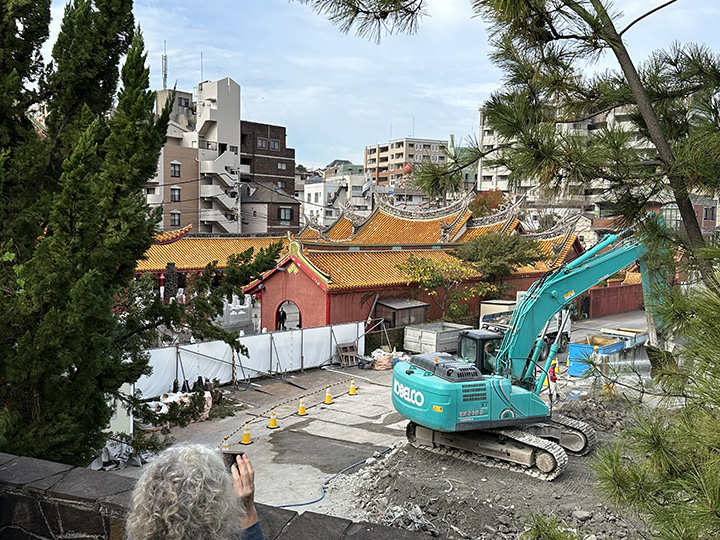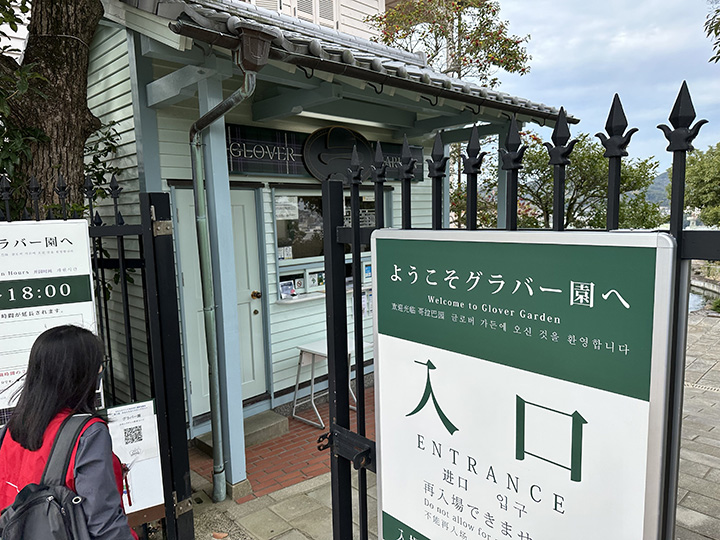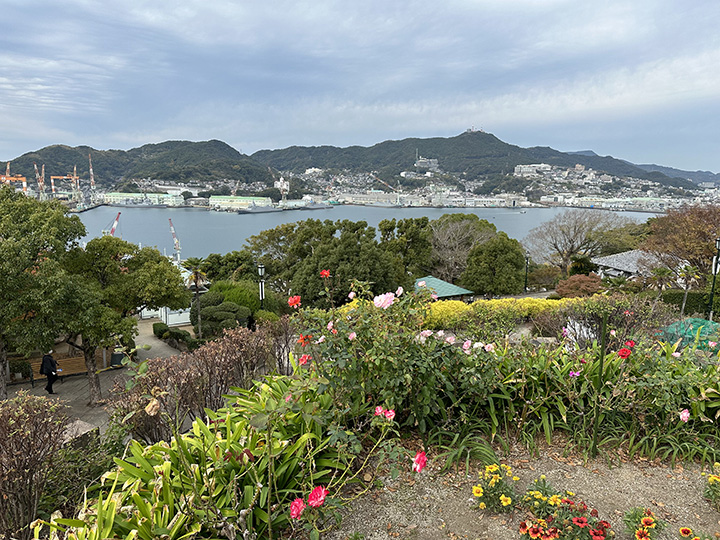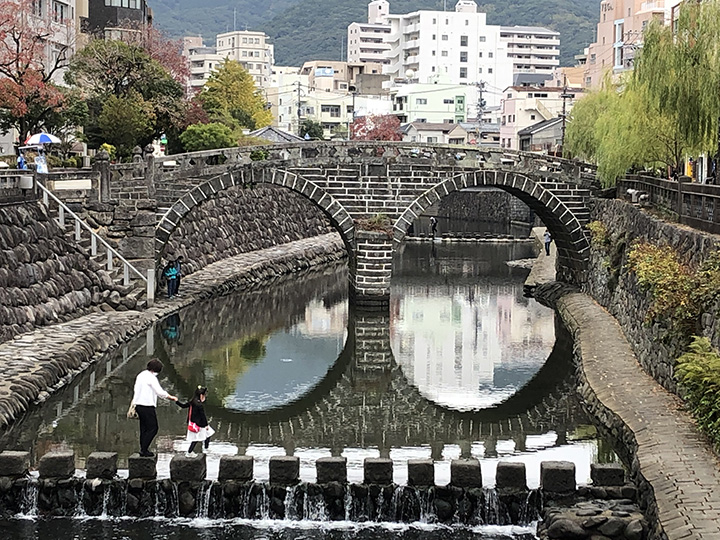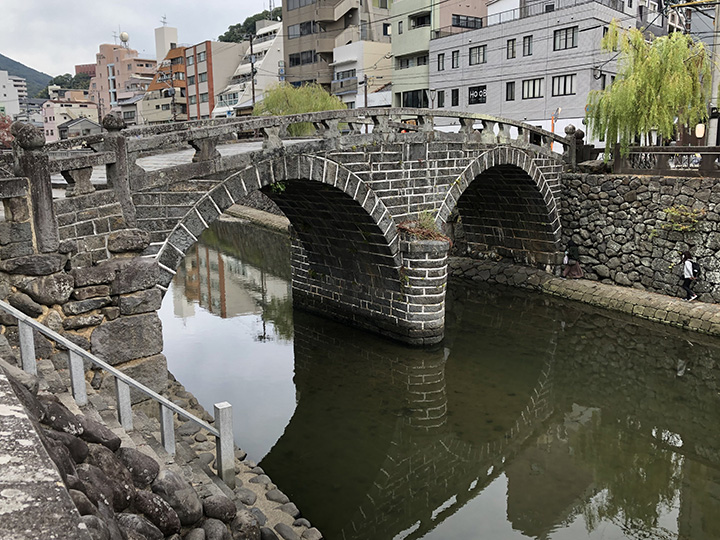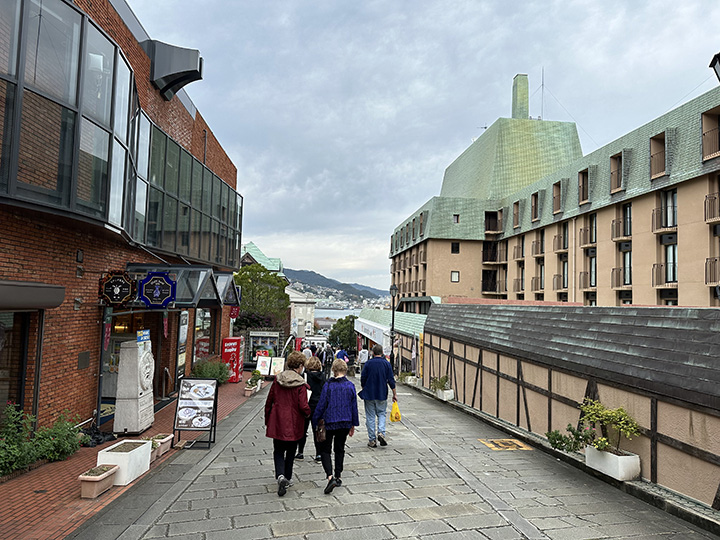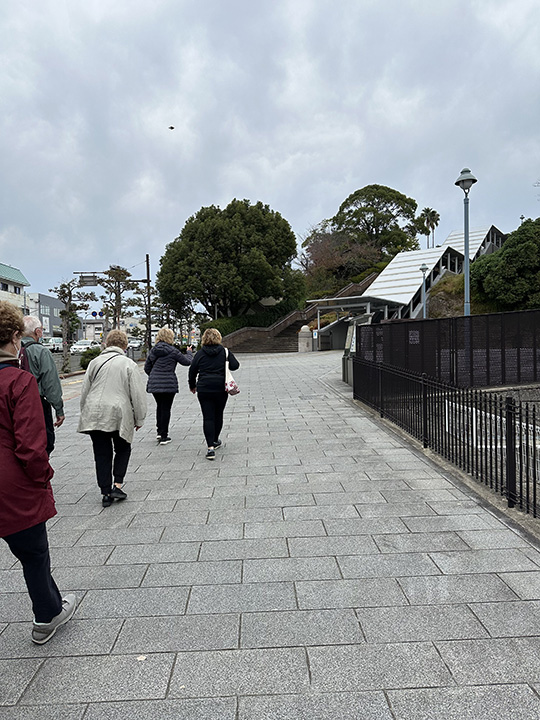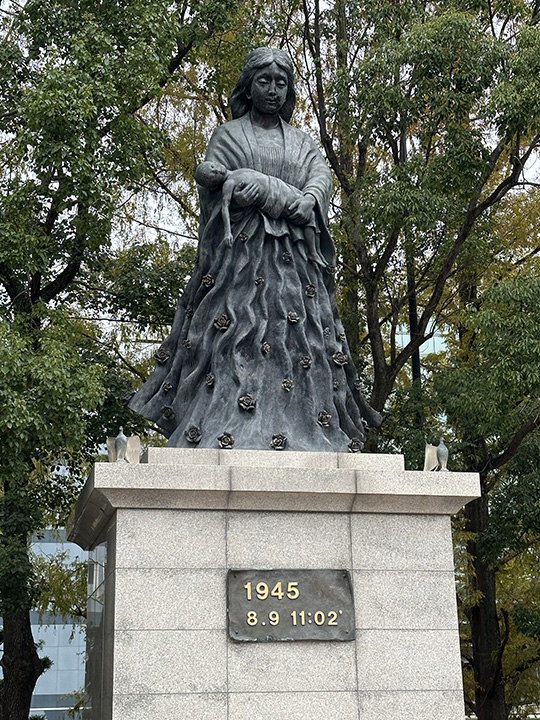|
I cannot believe that this is the penultimate day of the trip. One more day of touring tomorrow, and then I head home. Today I saw a Confucian shrine, walked through the gardens of a former enclave of foreigners, ate ice cream, ate some more ice cream, toured the Nagasaki atomic bomb museum, and went back to the wharf to enjoy pizza and French fries with my Road Scholar friends.
Here comes the tram that will take us to Chinatown.
Nagasaki has a fine tram system for getting around.
Know what that shop sells? Whale meat. It's not illegal here.
Itís hilly in Nagasaki.
There's supposed to be a good view of a Chinese Confucian shrine up here somewhere.
That house is a museum of some sort. Never was clear about it.
There, beyond that tree. There's an orange roof.
Maybe we can see better from the front porch.
Looks like a construction site down there.
Lots of activity.
The roof line is very artistic.
Especially on the Chinese temple.
You don't see this kind of thing on the Japanese temples.
Much more artwork up here.
Impressive.
Kōshi-byō is a Confucian temple in Nagasaki, Japan. Today the land on which it stands is owned by the Chinese Embassy in Tokyo.
People attach prayers to this tree.
I wonder what they say?
And this guy stands guard at the gate.
There's a bridge and a pond and some fish.
First built in 1893 by Chinese residents of Nagasaki with the support of the Qing dynasty government, the shrine was designed to serve as a place of worship and learning for the Chinese community, and housed a Confucian sanctuary and primary school. The buildings were severely damaged by the atomic bomb explosion on August 9, 1945 and were not restored and opened to the public until September 1967. The shrine was extensively renovated in 1982. Standing outside the shrine are 72 statues representing the 72 followers of Confucius.
They are all distinct individuals.
There are pretty decorations.
And there are lots of them.
Bill's impressed.
Intricate detail on a stone carving.
He is too pretty to be ferocious.
I think that is Confucius up there.
Yep. He is sort of hiding behind those dangly things.
I do believe I have found the armory that contains the weapons used by the guards in the castle of the wicked witch of the west.
A building at the rear of the shrine houses the Museum of Chinese History and Palace Museum. It features large illuminated photographs of the old Silk Road and models of early Chinese inventions such as the world's first seismograph. Displayed on the second floor are more than 80 treasure-class articles of varying antiquity on loan directly from the Chinese National Museum and Palace Museum in Beijing.
I'm telling you these guys are too pretty to be ferocious.
There are some real treasures in here.
Works of exquisite craftsmanship and art.
I mean, think of the time it took to create that.
Just look at that tusk.
And the detail in the carving. I feel bad for that baby though.
Detailed stone carving.
Detailed cork carving.
I think this is the first hole-in-the-floor toilets I've ever seen that flushes.
Now we're headed to the top of that hill. There's a funicular in that tunnel thing.
It would take only a few Road Scholars at a time.
We could watch them going up. Kinda creepy spying on them like that, but the monitor was right there, so...
View from the summit.
Up top thereís a nice view of Omura Bay.
The atomic bomb devastated Nagasaki even though it missed its target. It was supposed to fall on the shipyards on this side of that hill, but it fell on the other side of the hill. The shipyards were somewhat protected and therefore damaged but not destroyed.
Glover Garden is a park built for Thomas Blake Glover, a Scottish merchant who contributed to the modernization of Japan in shipbuilding, coal mining, and other fields. In it stands the Glover Residence, the oldest Western-style house surviving in Japan and Nagasaki's foremost tourist attraction.
Kathleen gives us the lay of the land.
Glover's mansion and his garden are located on the Minamiyamate hillside overlooking Nagasaki harbor. The house was built by Hidenoshin Koyama of Amakusa island and completed in 1863. It has been designated as an Important Cultural Asset. As the house and its surroundings are reminiscent of Puccini's opera, it is also known as the "Madame Butterfly House." Statues of Puccini and diva Miura Tamaki, famed for her role as Cio-Cio-san, stand in the park near the house. This house was also the venue of Glover's meetings with rebel samurai, particularly from the Chōshū and Satsuma domains.
So if you use your imagination, this is the spot where Butterfly could see the USS Abraham Lincoln anchored in the bay.
There's still a shipyard over there.
With some pretty modern ships.
And there are lovely flowers in the garden.
And fountains.
And fall colors.
And even Giacomo Puccini himself. Apparently some Americans who lived here after World War II ended in 1945 are the culprits who decided there was a link between these gardens and Madam Butterfly. The idea is stuck and people started calling the Glover house the Madame Butterfly house. Eventually Italy donated a statue as a sign of friendship.
Is that an ice cream stand I see over there?
This vanilla ice cream cone may be the best ice cream cone Bill has ever eaten. Except maybe for that other vanilla ice cream cone he had near the beginning of the trip. The Japanese do know how to make a vanilla ice cream cone.
Don told me the chocolate was better than the vanilla and he was correct in the saying the chocolate was excellent, but I have to tell you itís not as good as the vanilla.
At the bottom of Glover Garden Hill is the Nagasaki Traditional Performing Arts Center. Displayed here are items used in Nagasakiís autumn Kunchi festival. It is the most famous festival in Nagasaki. It began as a celebration of autumn harvests in the late 16th century and became a shrine festival when Suwa Shrine was founded in 1642. Another purpose was to check for hidden Christians after the ban on Christianity. This is still evident today in the custom of garden showing, when the presenting neighborhoods open up their homes to public scrutiny.
One of the most famous performances of the festival is the Dragon Dance which was originally performed on New Year's Eve by the Chinese residents of Nagasaki. Rehearsals for the festival begin on June 1. From October 7Ė9 the presentations of the festival, which vividly reflect Nagasaki's colorful history, spill over from the three festival sites into the streets and create an atmosphere of celebration throughout the city.
These are some of the dragons they use in the Dragon Dance.
Decorations from the festival.
Kaori got a great shot I totally missed.
There's even a Part II.
Itís a Christian Church in Japan!
Let's go find something to eat.
We walked past a pretty garden and I took a picture.
I don't know what those red things are used for in this building. Garbage chutes? Anyway, it looked unusual and I took a picture.
There was a nice Westin Hotel right there on the corner and some of us went in for a nice western style lunch. I had a pork cutlet with a salad and it was all just delicious.
And that was it for Road Scholar touring today. The schedule was arranged to give us lunch on our own and then the rest of the day free to do what we wanted in Nagasaki. Seven of us had a nice lunch in a hotel dining room and then headed off together to see Nagasakiís atomic bomb peace garden
We are figuring out the streetcars on our own.
We think the Peace Park is up there somewhere.
This sign indicates it is.
The fountain is designed to look like the wings of a dove.
These, I think, are angels.
They are part of a very touching memorial. I had read at the Hiroshima atomic bomb museum that victims begged desperately for water.
Visitors still bring water to the memorial.
That is all thatís left of a prison that was directly under the bombís blast.
This is called the Peace Statue. The right hand points to the atomic bomb; the left hand points to peace; and the face is a solemn prayer for the victims of the war. Well, thatís what the sculptor said.
That is Ground Zero or the epicenter or, as they call it in Japan, the hypocenter.
Since 1945 the area has been built up so much that the ground affected by the atomic bomb is now buried. Excavations show the results of the bomb.
This is what the area looked like after the blast.
A mother holds her dead child.
There was a museum dedicated to the atomic bomb explosion at Nagasaki. Those of the remains of a church that was left with walls standing but little else. They have moved the side of the church to the museum.
Rubble from the building in the photo.
Fat man.
The silhouette of a lookout and his ladder remain on a wall.
As with the museum in Hiroshima, the Nagasaki museum is filled with stories of suffering and horror, all presented in an effort to ensure we never forget.
It was getting late and we were hungry.
so we headed down to the wharf to enjoy a little food and drink by the water.
Bill, Suzanne, Linda, Charlie, Cory. We had a good day.
|









